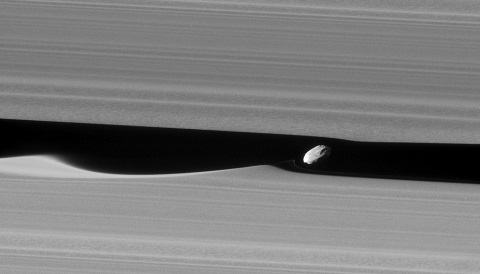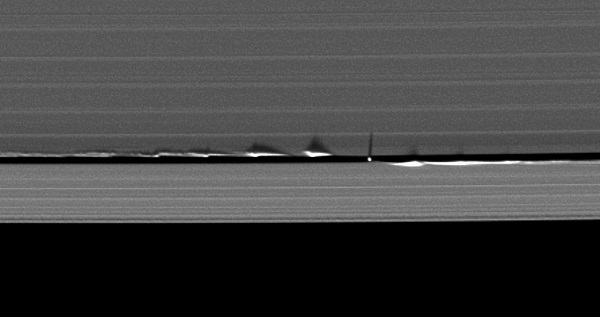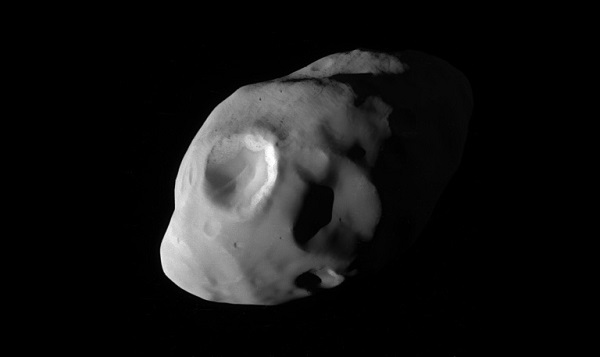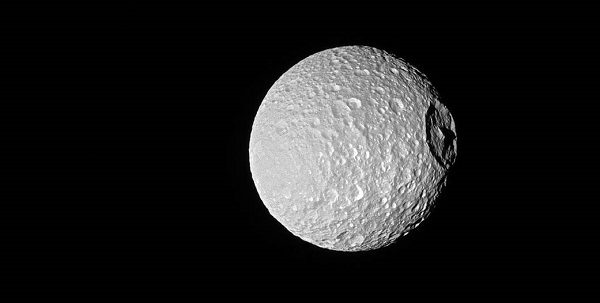Now that Cassini is in its "ring-grazing orbits" phase, it has returned stunning new views of Daphnis and friends.

NASA / JPL-Caltech / Space Science Institute
It's not every day humanity gets a fresh look at a distant world. NASA's Cassini mission recently released a new image of the tiny moon Daphnis enmeshed in the rings of Saturn.
Cassini took the image on January 16, 2017, while 17,000 miles (28,000 kilometers) away from the moon. Measuring 5 miles (8 kilometers) along its longest axis, irregular Daphnis resides in the 26-mile (42-kilometer) wide Keeler Gap in Saturn's outer A ring. The Keeler Gap seems narrower than it really is in this image because of foreshortening due to the spacecraft's viewing angle. You can just see grooves along the long axis of Daphnis in the image, as well as a few impact craters.

NASA / JPL / Space Science Institute
For context, the range at which this image was taken is about 6,000 miles closer than geosynchronous orbit (22,236 miles above Earth's surface). And for scale, Daphnis is slightly smaller than Mars' moon Deimos. At this distance, the image scale is 551 feet (168 meters) per pixel. This marks the closest flyby Cassini or any spacecraft has made past Daphnis to date.
Making Waves in Saturn's Rings
Despite its tiny size, the gravity of the diminutive moon raises ripples along the ring's edge in both the vertical and horizontal directions. In fact, if you look closely, you'll see that Cassini caught Daphnis in the act of drawing out a narrow tendril of ring material, which trails the moon in its orbit. "The gravity from this incredibly tiny moon is creating the Keeler Gap and sculpting Saturn's magnificent rings," says Cassini project scientist Linda Spilker (Jet Propulsion Laboratory). "This picture is Cassini's last close view of Daphnis."
Cassini also caught sight of Daphnis stirring things up back in 2009, during the Equinox phase of its mission. Soft-edged waves in Saturn's rings trail the moon's wake in this image too, in stark contrast to the otherwise sharp edges seen along the length of the Keeler Gap.

NASA / JPL / Space Science Institute
The Daphnis flyby is part of Cassini's recent series of ring-grazing orbits, which will span November 2016 to April 2017. "Cassini is currently orbiting Saturn... flying just inside Saturn's F ring," Says Spilker. "These grazing orbits provide some of our best views ever of Saturn's tiny ring moons, Saturn's F ring and outer A ring." In addition to Daphnis, Cassini will also make close passes of other ring residents including Methone, Pandora, Atlas, Prometheus, Aegaeon, and Pan.

NASA / JPL / Space Science Institute
The Cassini imaging team discovered Daphnis on May 6, 2005. The moon is named after the shepherd and friend of the satyr Pan in Greek mythology, appropriate as both Pan and Daphnis are "shepherd moonlets" tending to gaps in Saturn's rings. Daphnis orbits Saturn once every 14 hours. Not only does Daphnis appear “groovy” up close, but it also looks to be coated with ring material — features that are both typical of several of Saturn's inner moons.
“That's No Moon”
Except in this case, it is. Daphnis is only the latest in a series of moon cameos. On October 22, 2016, Cassini made one more flyby 115,000 miles (185,000 kilometers, about half the Earth-Moon distance) past Mimas, the moon that imitates Star Wars' Death Star in appearance. The flyby occurred just before the start of the ring-grazing orbits.

NASA / JPL-Caltech / Space Science Institute
The close-up shows Herschel Crater in stark profile along the terminator. The feature is testament to an ancient impact that may have nearly shattered the moon. Herschel Crater spans 86 miles (139 kilometers) in diameter, about one-third the diameter of Mimas itself.
After this coming April, Cassini's final days begin as it completes it dramatic Grand Finale orbits and threads the 1,240-mile-wide (2,000-kilometer-wide) gap between innermost rings and Saturn itself for 22 final orbits. Then will come the bittersweet moment on September 15, 2017, when Cassini ends its spectacular career of planetary exploration, taking the plunge and burning up in Saturn's atmosphere. Though dramatic, the move is also practical as an effort to avoid any possibility of contamination on Titan or Enceladus in the far future.
Enjoy these final views from an amazing mission. Human emissaries won't make their way to Saturn again for some time to come.
 9
9









Comments
Anthony Barreiro
January 24, 2017 at 4:54 pm
Regarding the width of the Keeler gap, 26 miles would be 42 kilometers, not the other way around.
My own preference would be to report all quantities in the metric system. This is consistent with scientific publications, and how everybody in the rest of the world outside the US does it. Readers who prefer miles over kilometers can do their own conversions.
You must be logged in to post a comment.
Zigarro
February 1, 2017 at 7:45 am
Bet you're fun around the breakfast table. 🙁 Besides, they, in Great Briton, use 'miles' as well. Who's it hurt?
You must be logged in to post a comment.
Frank-ReedNavigation.com
January 26, 2017 at 2:47 pm
Should we throw out AUs and lightyears and parsecs, too? They're not proper metric units. At the other end of the scale, should we religiously use nanometers and picometers and never mention angstroms again? It's true that rare and obsolete units should be (and are) discouraged by publication style books, but miles and feet are part of our daily culture and language, much as lightyears and angstroms are part of scientific culture. Consistency with "scientific publications" is not a great standard for comprehension and education...
By the way, some miles are downright metric! Nautical miles can be (almost) exactly matched to metric units: 54 nautical miles equal 100 kilometers (with only a tiny difference due to modern re-definitions). And it's no accident. The definition of the "sea mile" or "nautical mile" directly inspired the original definition of the kilometer. There are 90 degrees from equator to pole each containing 60 miles in the nautical system, and similarly there are 100 "grads" (a disused angular unit) each containing 100 kilometers in the original metric system. Hence 54 n.m. = 100 km. 🙂
Frank Reed
Conanicut Island, New England
You must be logged in to post a comment.
Anthony Barreiro
January 26, 2017 at 3:08 pm
To take your rhetorical question seriously, I would throw out the parsec but keep the AU and the light year. The AU is a handy frame of reference for distances within a solar system and the light year for distances between solar systems, and within and between galaxies, up until you need to start taking cosmic expansion into account, in which case z, red-shift, is the appropriate unit. The parsec is of purely historical interest, and essentially redundant with the light year.
At the lower end of the scale, yes, I see no reason, beyond historical fussiness, to say 1 angstrom when you could just say 10 nanometers.
Nautical miles are a special case. The equivalence between an arcminute of latitude and a nautical mile makes the nautical mile a convenient measure for navigation. One less opportunity for calculation errors, which can be deadly at sea. Still, when you read a paper on oceanography, they'll use kilometers.
In general, we Americans need to catch up with the rest of the world and start thinking metric. Popular science publishers like Sky and Telescope can help us do that by routinely reporting values in metric units, perhaps providing one parenthetical conversion to English units (which not even the English use any more) to give antediluvian readers a sense of scale.
You must be logged in to post a comment.
David-S
January 27, 2017 at 4:56 pm
Anthony: As you may recall the education system in the US attempted to teach the metric standards in the past and failed. Most likely due to trying to teach children to convert from the Imperial standard to the metric with formulas instead of just saying, "OK, this is how long a centimeter is. Now you know. Use it."
You must be logged in to post a comment.
Anthony Barreiro
January 31, 2017 at 2:24 pm
Exactly!
You must be logged in to post a comment.
rodmichael
January 27, 2017 at 6:15 pm
The greatest industrial economy in the world and the home of the most substantial scientific progress in the 20th century was built on the English system of measure which significantly antedates the Metric system devised in about 1800. Why should the greatest industrial economy and system follow just because lesser industrial economies do. I would say that the imposition of the Metric system on the world could be perceived as a measure of French and European chauvinism and of US Europhiles and Euro wannabes.
You must be logged in to post a comment.
Anthony Barreiro
January 31, 2017 at 2:26 pm
But Rod, the greatest industrial economy in the world, China, uses the metric system. 🙂
You must be logged in to post a comment.
AndyLiakos
February 3, 2017 at 4:56 pm
Indeed, and don't forget they are the most free, the most civilized, and of course the most ethical economy too! 🙂
You must be logged in to post a comment.
You must be logged in to post a comment.